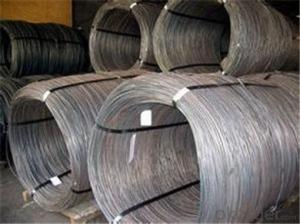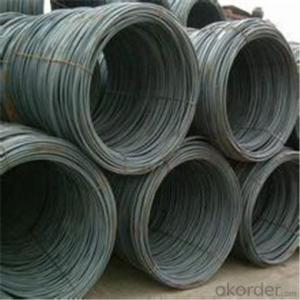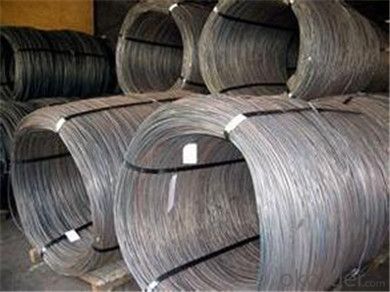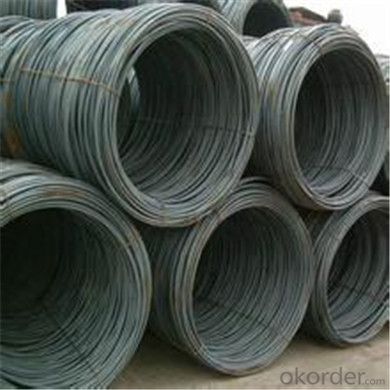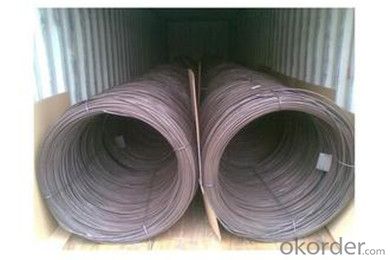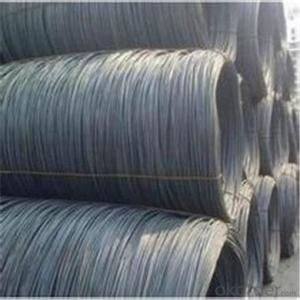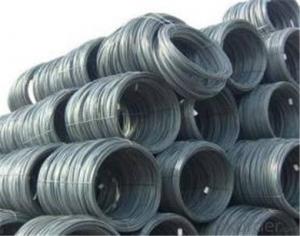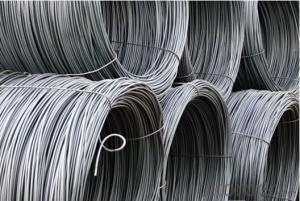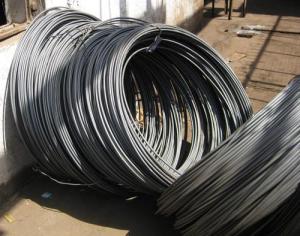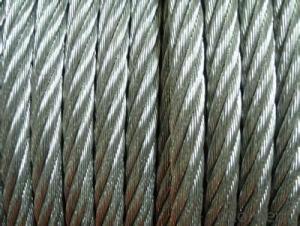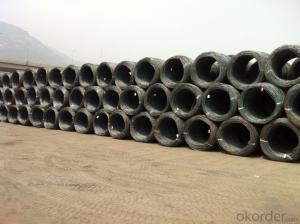SAE1008Gr Steel Wire rod 6.5mm with Best Quality
- Loading Port:
- Shanghai
- Payment Terms:
- TT OR LC
- Min Order Qty:
- 99 m.t.
- Supply Capability:
- 45555555 m.t./month
OKorder Service Pledge
OKorder Financial Service
You Might Also Like
Specification
Description of wire Rod:
wire rod:
Grade:SAE1006B/SAE1008B/SAE1018B
Size:5.5/6.5/7/8/9/10/11/12mm
Festures of wire Rod:
· Umbrella ribs, upholstery wires, cycle spokes, needle wires, heald wires, staple pin Wire, safety pin wires
· ACSR wires, earth wires,
· tyre and hose reinforcement wires
· prestressed concrete wire, springs and rope wires,
· card clothing wires,
· vineyard wires,
Specifications of wire Rod:
Grade | Chemical Composition(%) | |||||
C | Mn | Si | S | P | Cr | |
SAE1008B | 0.10max | 0.3~O.50 | 0.15max | 0.050max | 0.040 max | 0.3-0.35 |
Mechanical properties | ||||||
Yield strength(N/mm2) | Tensile strength(N/mm2) | Elongation(%) | ||||
≥195 | 315-430 | ≥30 | ||||
| Packaging Details: | (1) Coils are wrapped by 8 steel strips; (2) Wrapped by waterproof cloth; (3) Wrapped by 8 steel strips (6+2) ; (4) Added with wood pallet |
Images of wire Rod:
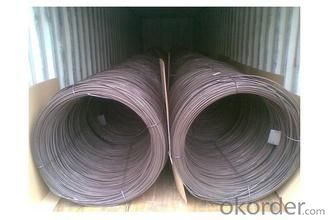
FAQ:
1. What is your package?
Packing situation: standard seaworthy packing or as customer required.
2. How long is the lead time?
Delivery time: 45 days after order confirmed.
3. What payment term do you accept?
Payment: T/T or L/C at sight.
- Q: How is steel wire rod used in the manufacturing of wire forms for material handling?
- Wire forms for material handling are manufactured using steel wire rod. This rod undergoes different manufacturing techniques such as drawing and rolling to refine and shape it into the desired dimensions and properties. The resulting wire is then processed and treated to enhance its strength, durability, and resistance to corrosion. Once transformed into wire forms, they are utilized in various ways within material handling equipment. For example, hooks are created and attached to lifting devices like cranes or hoists, providing a secure means of lifting and transporting heavy loads. Additionally, loops can be shaped from wire forms and used as handles or gripping mechanisms on material handling tools and equipment. These loops enable operators to safely manipulate or control the movement of objects during material handling processes. Wire forms can also be coiled into springs, which provide flexibility, shock absorption, and resistance to deformation. This ensures the smooth and efficient operation of material handling equipment, such as conveyor systems. In conclusion, steel wire rod is a crucial component in the manufacturing of wire forms for material handling. Through various manufacturing processes, it is transformed into hooks, loops, and coils that play a vital role in lifting, gripping, and controlling objects during material handling operations. The versatility and durability of wire forms make them indispensable in a wide range of material handling applications.
- Q: How are surface defects in steel wire rod repaired or rectified?
- Surface defects in steel wire rod can be repaired or rectified through various methods. One common method is grinding or sanding, where the surface defect is removed by using abrasive materials or tools. This process eliminates any imperfections or irregularities on the surface, resulting in a smooth and even finish. Another method is called peeling, which involves removing a thin layer of the affected area using a peeling machine. This helps to eliminate any superficial defects, such as scale or oxidation, and improves the overall quality of the wire rod. In some cases, the defects may be too severe to be repaired through grinding or peeling alone. In such situations, the wire rod can undergo a process known as pickling or acid cleaning. This involves immersing the rod in an acidic solution, which removes any corrosion, scale, or other surface defects. After pickling, the wire rod is thoroughly rinsed and dried to prevent further damage. Electropolishing is another technique used to repair surface defects in steel wire rods. It involves immersing the rod in an electrolyte solution and applying an electric current. This process removes a controlled amount of material from the surface, effectively eliminating any defects and producing a smooth and polished finish. In addition to these mechanical and chemical methods, surface defects in steel wire rods can also be repaired through heat treatment processes. Annealing, for example, involves heating the wire rod to a specific temperature and then slowly cooling it down. This process helps to relieve internal stresses and improve the overall structure and surface quality of the rod. Overall, the repair or rectification of surface defects in steel wire rods requires a combination of techniques, depending on the severity and type of defect. By employing these methods, manufacturers can ensure that the wire rods meet the required quality standards and are suitable for their intended applications.
- Q: What are the different corrosion protection methods for steel wire rod?
- There are several corrosion protection methods for steel wire rod, including galvanization, coating with epoxy or polyurethane, and using corrosion inhibitors. Galvanization involves applying a layer of zinc to the surface of the wire rod, which acts as a sacrificial anode and prevents corrosion. Coating the wire rod with epoxy or polyurethane provides a barrier against moisture and corrosive substances. Additionally, corrosion inhibitors can be used to prevent the formation of rust on the wire rod by inhibiting the chemical reactions that cause corrosion.
- Q: What are the standard tensile strength requirements for steel wire rod?
- The standard tensile strength requirements for steel wire rod vary depending on the specific grade and application. However, commonly used steel wire rods typically have a tensile strength range of 400 to 1000 megapascals (MPa).
- Q: What are the different types of steel wire rod surface finishes?
- There are several types of steel wire rod surface finishes, including black oxide, galvanized, phosphatized, and coated finishes.
- Q: What are the common applications of spring steel wire rod?
- Spring steel wire rods have a wide range of applications due to their unique properties. Some common uses include manufacturing springs, wire forms, clips, fasteners, and mechanical components such as shafts and pins. They are also used in the automotive industry for suspension systems, seat frames, and engine components. Additionally, spring steel wire rods are utilized in the construction industry for reinforcing concrete, as well as in the manufacturing of various tools and equipment.
- Q: How is steel wire rod used in the manufacturing of wire rope assemblies for construction purposes?
- Steel wire rod is an essential component in the manufacturing of wire rope assemblies for construction purposes. It serves as the raw material from which wire ropes are created. Wire rod is drawn through various dies to reduce its diameter and increase its strength, resulting in high-quality steel wires. These wires are then twisted and braided together to form the wire rope, which exhibits exceptional tensile strength, flexibility, and durability. Wire rope assemblies made from steel wire rod are commonly utilized in construction applications such as lifting heavy loads, suspending structures, and providing safety measures.
- Q: What are the common industry standards for steel wire rod?
- The common industry standards for steel wire rod include specifications such as the American Society for Testing and Materials (ASTM) A510, A510M, and A580, as well as the International Organization for Standardization (ISO) 16120 and 16124. These standards outline the requirements for the quality, dimensions, mechanical properties, and testing procedures of steel wire rod used in various industries.
- Q: What are the main factors influencing the choice of steel wire rod delivery time?
- There are several key factors that influence the choice of steel wire rod delivery time. Firstly, the availability of raw materials plays a significant role. The production of steel wire rods requires various raw materials such as iron ore, coal, and scrap metal. The availability and accessibility of these materials can impact the production process and ultimately affect the delivery time. Secondly, the overall demand for steel wire rods in the market is an important factor. If there is high demand for steel wire rods, the production and delivery time may be longer due to increased order volumes. Conversely, if demand is low, suppliers may be able to deliver the product more quickly. Thirdly, the production capacity of the steel mill or manufacturer is a crucial factor. If the steel mill has limited capacity or is running at full capacity, it may take longer to fulfill orders and deliver the wire rods. On the other hand, if the production capacity is high, the delivery time may be shorter. Additionally, logistical factors such as transportation and shipping can also impact the delivery time of steel wire rods. If there are delays or disruptions in the transportation network, it may prolong the delivery process. Moreover, the distance between the steel mill and the customer's location can affect the delivery time as well. Lastly, external factors like weather conditions, labor strikes, or unforeseen events can also influence the choice of steel wire rod delivery time. These factors may cause disruptions in the production process and affect the overall delivery timeline. In conclusion, the main factors influencing the choice of steel wire rod delivery time include the availability of raw materials, market demand, production capacity, logistical factors, and external events. It is essential for manufacturers and customers to consider these factors when planning for the delivery of steel wire rods.
- Q: How is the steel wire rod market affected by changing customer preferences?
- The steel wire rod market is significantly affected by changing customer preferences. As customer preferences evolve, the demand for specific types of steel wire rods can fluctuate. One way changing customer preferences impact the market is through the demand for different grades of steel wire rods. For example, if customers prefer higher strength and durability, there may be an increased demand for high-carbon steel wire rods. Conversely, if customers prioritize cost-effectiveness and flexibility, there may be a higher demand for low-carbon steel wire rods. These changing preferences influence the production and supply chain of steel wire rods, as manufacturers need to adapt their processes to meet the requirements of the market. Additionally, changing customer preferences also affect the use of steel wire rods in various industries. For example, if there is a growing trend towards lightweight and eco-friendly products, industries such as automotive and construction may shift towards using steel wire rods with specific characteristics that align with these preferences. This can lead to changes in the demand for different types of steel wire rods and impact the overall market dynamics. Furthermore, customer preferences for sustainable and environmentally friendly materials can also influence the steel wire rod market. If customers prioritize materials with lower carbon emissions and higher recyclability, manufacturers may need to invest in new technologies or processes to produce steel wire rods that meet these preferences. This can lead to changes in production methods, sourcing of raw materials, and overall market competitiveness. Overall, the steel wire rod market is highly responsive to changing customer preferences. Manufacturers and suppliers need to closely monitor and understand these preferences to effectively meet the demands of the market and stay competitive. Adapting to evolving customer preferences is crucial for the growth and sustainability of the steel wire rod industry.
Send your message to us
SAE1008Gr Steel Wire rod 6.5mm with Best Quality
- Loading Port:
- Shanghai
- Payment Terms:
- TT OR LC
- Min Order Qty:
- 99 m.t.
- Supply Capability:
- 45555555 m.t./month
OKorder Service Pledge
OKorder Financial Service
Similar products
Hot products
Hot Searches
Related keywords
